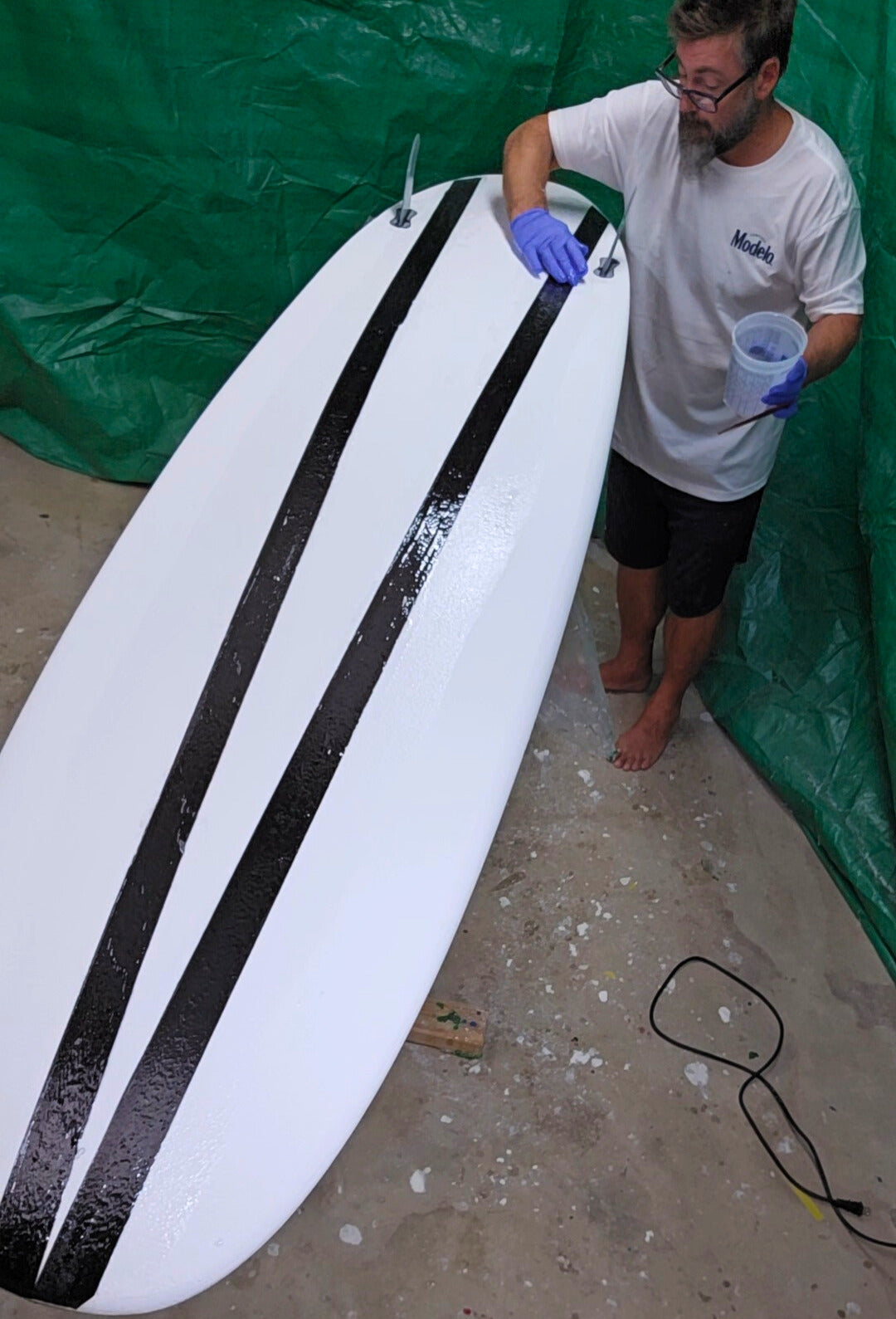
Are Stringers Necessary in Modern Surfboards?
In the world of surfboard construction, stringers have long been a standard feature. Traditionally, stringers—thin strips of wood placed down the center of the board—have provided the necessary structural strength and stiffness to keep surfboards intact under the stress of waves and maneuvers. However, with advancements in modern surfboard materials and construction techniques, the necessity of stringers has become a topic of debate. This article will explore whether stringers are still essential in modern surfboards by comparing EPS (Expanded Polystyrene) and PU (Polyurethane) foams, discussing construction methods, and evaluating variables like foam thickness, fiberglass lap length, and carbon fiber reinforcements.
The Evolution of Surfboard Stringers
Stringers became popular in the 1950s as shapers sought to stiffen boards and prevent flex that could cause snapping. A balsa wood stringer would be placed down the center of the board, providing strength while maintaining some flexibility. For decades, the classic PU (polyurethane) surfboard with a wooden stringer remained the industry standard.
As technology advanced, new materials like EPS (Expanded Polystyrene) foam emerged, and with them came the possibility of experimenting with stringerless construction. In this new era of surfboard shaping, carbon fiber and other composite materials offer strength and flexibility, challenging the need for traditional stringers.
Comparing EPS and PU Foam: Strength and Flex
PU (Polyurethane) Foam
PU foam, the classic choice for surfboards, is known for its dense and smooth feel. When paired with a wooden stringer, PU foam provides a balanced mix of strength and controlled flex, resulting in the "classic" ride feel many surfers prefer. However, PU foam is heavier than its EPS counterpart, and when damaged, it absorbs water, leading to deterioration over time.
Advantages of PU Foam with Stringers:
Traditional feel: PU boards have a predictable flex pattern that many surfers are familiar with.
Stiffness: The stringer provides adequate stiffness, reducing the risk of snapping.
Durability: PU foam holds up well when reinforced with fiberglass and carbon fiber.
Disadvantages:
Heavier weight: PU is denser, which results in a heavier board.
Susceptibility to water damage: When damaged, PU foam can absorb water, weakening the board structure.
Less eco-friendly: PU foam and the resin used in glassing are not as environmentally sustainable as EPS.
EPS (Expanded Polystyrene) Foam
EPS foam has become a favorite among shapers for creating lightweight, high-performance surfboards. EPS is a lighter and more buoyant alternative to PU foam, making it ideal for surfers looking for increased speed and maneuverability. However, it is more flexible and less dense, raising the question of whether it requires a stringer for structural support.
Advantages of EPS Foam:
Lightweight: EPS boards are significantly lighter, which enhances speed and maneuverability.
Increased buoyancy: EPS foam’s buoyant properties allow for easier paddling and faster takeoffs.
Compatible with epoxy resin: When paired with epoxy resin, EPS boards tend to be more durable and less prone to dings than traditional PU boards with polyester resin.
Disadvantages:
Flexibility: EPS foam is more flexible and prone to bending without proper reinforcement, leading to a need for additional structural elements like carbon fiber.
More difficult to shape: EPS beads can be tricky to work with, requiring more precision and skill during shaping.
Stringerless Construction: New Approaches with Carbon Fiber
Modern stringerless surfboards, particularly those made from EPS foam, rely on composite materials like carbon fiber to achieve the necessary strength and stiffness without the traditional wooden stringer. Carbon fiber offers an ideal combination of low weight, high tensile strength, and stiffness, making it a suitable reinforcement material. These boards are often referred to as "stringerless" even though they still rely on reinforcement to maintain structural integrity.
Carbon Fiber Reinforcement Techniques
1. Carbon Fiber Tapes: Carbon fiber tapes are applied along the rails or the deck of the board. This technique offers additional stiffness and helps to control flex without sacrificing the lightweight properties of the EPS foam. Carbon fiber tape is often used strategically in areas prone to high stress, such as near the tail or the bottom contour.
2. Carbon Fiber Deck Patches: Reinforcing the deck with carbon fiber patches can improve the overall strength of the board while allowing for a controlled flex pattern. Deck patches are commonly applied under the front foot area, where pressure and impact forces are highest.
3. Full Carbon Wraps: In some high-performance boards, shapers may opt for a full carbon wrap around the EPS core. This method provides maximum stiffness and durability, but it can also affect the overall feel of the board, making it too rigid for some surfers’ tastes.
Construction Techniques: Glassing, Foam Thickness, and Lap Length
The construction techniques used in both PU and EPS surfboards play a critical role in determining whether stringers are necessary. In modern surfboards, glassing (the application of fiberglass cloth and resin) can be adjusted to enhance or reduce stiffness and strength. Let's explore the key variables:
Foam Thickness
Foam thickness directly impacts the stiffness and strength of a surfboard. In stringerless EPS boards, increasing foam thickness is one way to compensate for the absence of a wooden stringer. A thicker blank inherently offers greater stiffness and strength, which helps prevent unwanted flex and breakage. However, increased thickness also changes the board's buoyancy and weight distribution, which may not suit every surfer’s preference.
Increased Foam Thickness Pros and Cons:
Pros: More stiffness, less prone to snapping, suitable for larger and more powerful waves.
Cons: Adds volume, which may affect performance, and changes the feel and ride characteristics.
Fiberglass Lap Length
Lap length—the area where the fiberglass wraps around the rails and overlaps on the other side of the board—affects the board’s structural integrity. Stringerless boards often rely on longer laps to compensate for the absence of a central stringer. A longer lap increases the strength of the rails and minimizes the risk of cracks and dings, as it provides additional layers of reinforcement.
Longer Lap Length Pros and Cons:
Pros: Reinforces rails, increases board strength, and improves durability.
Cons: Adds weight and may stiffen the board more than desired, reducing flexibility.
Carbon Fiber Reinforcements
In stringerless surfboards, carbon fiber reinforcements play a crucial role in fine-tuning the flex and strength of the board. By strategically placing carbon fiber tapes or patches, shapers can control where the board flexes and how it responds under pressure.
Stiffening the Tail: Adding carbon fiber reinforcements around the tail helps maintain drive and control during turns and maneuvers. This setup is popular in high-performance shortboards, where quick response times are essential.
Reinforcing the Rails: Rail reinforcement with carbon fiber adds strength and rigidity to the sides of the board, improving durability and maintaining the overall shape of the board when subjected to the powerful forces of wave impact.
PU vs. EPS: Which Foam Works Best with Stringerless Designs?
While both PU and EPS foams can be used in stringerless designs, EPS is often the preferred choice due to its lightweight properties and compatibility with modern reinforcement techniques. Here’s a quick comparison:
EPS Foam with Carbon Fiber Reinforcement: Lightweight and buoyant, EPS foam is ideal for stringerless boards when combined with carbon fiber reinforcements. The use of carbon fiber compensates for the foam’s inherent flexibility, resulting in a lightweight yet strong board.
PU Foam without a Stringer: While it’s possible to create PU boards without stringers, they require substantial fiberglassing and carbon fiber work to maintain stiffness, which can add weight and reduce some of the flex advantages typically seen with EPS.
Conclusion: Are Stringers Still Necessary?
Whether stringers are necessary in modern surfboards depends on the materials and construction techniques used. Traditional PU boards often still rely on stringers for their classic feel and predictable flex pattern. However, advancements in EPS foam technology, combined with carbon fiber reinforcements, offer shapers and surfers an alternative that is lightweight, strong, and highly customizable.
Ultimately, for high-performance surfers looking for a responsive and flexible board, stringerless EPS designs with carbon fiber reinforcement are an excellent choice. For those who prefer a traditional feel or are working with PU foam, the classic stringer setup remains a reliable and effective option.
In short, stringers are not strictly necessary, but they are still a valuable tool for achieving specific board characteristics. With the right combination of materials—whether it’s thicker foam, carbon fiber tapes, or advanced fiberglassing techniques—modern surfboards can be customized to perform just as well, if not better, than traditional stringered designs.
